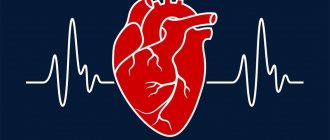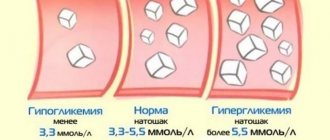Diabetes mellitus is a pathological condition characterized by impaired metabolic processes (metabolism). This happens due to insufficient production of the body’s own hormonal substance insulin, as in the case of type 1 diabetes mellitus or a violation of its effect on the cells and tissues of the body (type 2 pathology).
The article discusses in detail the main types of diabetes mellitus, the differences in their causes and mechanisms of development, as well as a description of the features of treating patients.
A little about insulin and its role in the human body
Insulin is a hormone produced by the pancreas. The organ is located behind the stomach, surrounded by the spleen and a loop of the duodenum. The weight of the pancreas is about 80 g.
In addition to hormones, the gland produces pancreatic juice, which is necessary for the digestion of lipids, carbohydrates and proteins. The hormone insulin is synthesized by β-cells. They are localized over almost the entire surface of the pancreas in the form of small groups called islets of Langerhans-Sobolev. The islets also contain α-cells that synthesize the hormonally active substance glucagon. This hormone has the opposite effect of insulin.
Important! A healthy adult has about a million of these islets with a total weight of several grams.
Insulin is a protein molecule that consists of several chains of amino acids. Its task is to absorb glucose (sugar) into the body's cells. Sugar is necessary for a person to get energy. Without it, cells and tissues are unable to cope with their functions.
In parallel with the intake of sugar, insulin also regulates the penetration of amino acids into cells. Amino acids are considered one of the main building materials. Another function of insulin is the accumulation of lipids in the body.
The pancreas is a multifunctional organ
Other types of diabetes
What other types of diabetes can there be? The development of the disease can occur in completely different ways. It depends on many factors. Thus, according to the nature of the course, two types of diabetes mellitus are distinguished:
- Labile. It is characterized by unpredictability and severe course. During the day, the quantitative composition of blood sugar can change several times. This is the difficulty of choosing the optimal dose of insulin. A similar form is often observed among representatives of the younger generation. Consequences of the disease: disturbances in the functioning of the kidneys and organs of vision.
- Stable. This form is characterized by mild symptoms and a fairly uniform course of the disease (that is, without any sudden changes in glucose levels).
Classification of diabetes mellitus
According to the generally accepted and used in modern endocrinology classification of diabetes mellitus, the pathology is divided into the following types:
- Type 1 – insulin dependent (IDDM);
- Type 2 – non-insulin dependent (NIDDM);
- gestational form;
- specific types of diabetes.
The latter option is a group of pathological conditions that differ from each other in their pathogenesis and causes of development. These include hereditary defects at the genetic level in the hormone insulin or insulin-secretory cells, diseases caused by the action of chemicals and medications, diabetes as a result of infectious processes, etc.
All types of diabetes have hyperglycemia in common. This is a condition that is characterized by elevated blood glucose levels. It is against the background of diagnosing glycemic figures that confirmation or refutation of the diagnosis of “sweet disease” is based.
Diagnostic methods
Diagnosis of pathology involves establishing the type and form of the disease, assessing weight and height, identifying complications and concomitant diseases. Initially, the specialist clarifies the symptoms and determines the presence of clinical signs of pathology. Next, a more thorough examination is necessary.
All types of diabetes and their signs require laboratory confirmation:
- Glycemic assessment. The analysis is carried out on an empty stomach. Normally, the sugar concentration is not higher than 5 mmol/l. An increase in these numbers indicates a disorder in glucose metabolism.
- Glucose tolerance test. Blood sampling is carried out on an empty stomach, one hour and 2 hours after taking 75 grams of glucose. The diagnosis is indicated by an overestimation of results of more than 11 mmol/l.
- Analysis of urine. Normally, there is no glucose in urine. In diabetes mellitus, an increase in glycemic values allows sugar to enter the urine through the kidneys. To exclude nephrogenic diabetes, urine density and osmolarity are analyzed.
To determine diabetes mellitus and diabetes insipidus, differential diagnosis is carried out. The volume of urine, its specific gravity and density are taken into account. A blood test does not reveal an increase in glucose levels.
The correct diagnosis can only be established by laboratory testing.
Gestational type
The WHO classification of diabetes mellitus includes the gestational form of the disease (ICD-10 code – O24). It is typical for pregnant women. 5-7% of patients who are carrying babies suffer from the “sweet disease”. The WHO classification of diabetes and its types also includes another name for this type of pathology – diabetes in pregnant women.
If a woman develops a disease before conceiving a child, it is considered pregestational; during pregnancy, it is considered gestational. At the moment, the mechanism of development and causes of the disease are not fully understood. There is evidence about the role of hereditary predisposition. Risk factors may include:
- physical and mental trauma;
- infectious diseases;
- pancreatic diseases;
- inclusion in the menu of large quantities of foods rich in carbohydrates.
Obstetricians and gynecologists agree that adequate physical activity can reduce the risk of developing pathology
The gestational form can manifest itself in the form of manifestation, that is, a vivid clinical picture, or in the form of impaired glucose tolerance. The pathology, as a rule, disappears on its own after the baby is born.
Important! The woman becomes a member of the group of patients at high risk of developing non-insulin-dependent diabetes mellitus over the next 10-15 years.
During the period of bearing a child, a woman’s body undergoes certain changes that are associated with the hormonal sphere. This is explained by the functioning of the placenta, which secretes the following hormones:
- human chorionic gonadotropin;
- progesterone;
- estrogens;
- corticosteroids, etc.
All these hormonally active substances cause insulin resistance. At this stage, hyperplasia of insulin-secreting cells and the release of large amounts of insulin into the blood are observed on the part of the pancreas. The appearance of insulin resistance leads to the fact that the woman’s body begins to actively use the products of fat metabolism, while sugar is retained in order to nourish the fetus. Under conditions of a combination of hereditary predisposition to the “sweet disease” and the above factors, the disease develops.
Symptoms
The gestational type of the disease manifests itself in the same way as other types of diabetes, but the symptoms are somewhat less pronounced. A woman may not pay attention to symptoms, associating their occurrence with her “interesting” situation. If the clinical picture is pronounced, the pregnant woman may present the following complaints to the attending physician:
Stages of diabetes development
- dry mouth;
- constant desire to drink;
- passing large amounts of urine;
- increased appetite;
- decreased performance and weakness;
- the appearance of itching and burning in the genital area.
Important! The disease usually develops at the end of the second or beginning of the third trimester.
The influence of pathology on mother and fetus
Chronic hyperglycemia negatively affects both the mother’s body and the child itself. Pregnancy can be complicated by:
- polyhydramnios;
- late gestosis;
- termination of pregnancy at different stages of gestation;
- the birth of a child with a large body weight (more than 4-4.5 kg).
Babies born from a sick mother have a characteristic appearance. Their shoulders are quite wide, subcutaneous fat is clearly expressed, and their face has a round, moon-shaped shape. There is significant swelling of the skin and hypertrichosis. The most severe complications of the disease are considered to be fetal death during intrauterine development and the death of a newborn. As a rule, such conditions occur in the presence of a pregestational form of the disease.
Children born from a sick mother differ from their peers in their large body weight and characteristic appearance
Causes of the disease
Type 1 diabetes mellitus has a different nature:
- the development of an autoimmune process that occurs as a result of a malfunction of the immune system;
- viral infection caused by rubella, hepatitis, mumps, chickenpox;
- genetic predisposition.
The second type of illness has two main prerequisites:
- obesity, the more pronounced it is, the higher the risk of developing diabetes;
- genetic conditioning.
Specific types
We are talking about secondary forms of a pathological condition that develop under the influence of chemicals, medications, infectious processes and other diseases of the endocrine and extraendocrine spheres.
The following diseases and conditions of the pancreas can cause diabetes:
- organ inflammation;
- mechanical damage;
- removal of the gland;
- neoplasms;
- cystic fibrosis;
- pigmentary cirrhosis, etc.
Of the chemicals and drugs that can contribute to the development of the disease, nicotinic acid, adrenal hormones, interferons, thyroid hormones, and diuretics. The list continues with opiates, poisons intended to kill rodents, antidepressants, and drugs used for antiretroviral therapy.
Important! Among the causative agents of infectious diseases, the triggering factors are the rubella virus and cytomegalovirus.
Features of treatment
Therapy for the pathological condition is selected individually for each clinical case. The regimen and methods of treatment used depend on the degree of diabetes, its type, the severity of the clinical picture, and the presence of complications. A qualified endocrinologist will tell you how to determine and confirm the presence of the disease. He will provide directions for the following diagnostic methods:
- general blood and urine tests;
- capillary blood test for glucose from a finger prick on an empty stomach;
- blood biochemistry;
- urine test for sugar;
- glucose tolerance test - mandatory for all expectant mothers during the period from 22 to 26 weeks of pregnancy;
- determination of glycosylated hemoglobin indicators.
Therapeutic measures include not only taking medications, but also physical therapy, nutrition correction, and teaching the patient self-control.
It is important that relatives support the sick person’s desire to reduce the aggressiveness of the pathological condition and achieve compensation
Self-control
Patients suffering from diabetes mellitus should keep track of their feelings, glycemic indicators, urine sugar levels, and also record data on an individual menu and physical activity throughout the day. The set of such indicators and their accounting is self-control. The purpose of such activities is not only to control sugar levels, but also to interpret the results, as well as plan your actions if the numbers are outside the acceptable range.
If you feel normal, it is important to measure your sugar levels at home and record these indicators at least once a day. Any changes in health require clarification of the amount of glucose in the blood several times a day:
- before each main meal;
- some time after food enters the body;
- before evening rest;
- in some cases, a morning fasting measurement may be necessary.
Glucose in urine is also measured at home. This requires express strips. They can be purchased at pharmacies. The presence of sugar in the urine will indicate that the blood glucose level exceeds 10 mmol/l, since this figure is the renal threshold at which glucose molecules penetrate into urine.
Important! If the patient is traveling, actively involved in sports, or has any underlying medical conditions, more stringent self-monitoring will be required.
For the daily comfortable living of a person with diabetes, it is necessary to purchase the following individual devices and devices:
- glucometer with lancets, test strips and necessary accessories included;
- express strips for urine, which measure the level of acetone bodies and sugar;
- tonometers to clarify blood pressure numbers;
- a self-monitoring diary, where all the necessary data will be recorded.
Nutrition
Correction of individual nutrition is the basis of treatment of any type of diabetes. With type 1, changing your personal menu allows you to reduce the load on the pancreas and reduce the amount of carbohydrates entering the body. In type 2 diabetes, a low-calorie diet allows you not only to achieve the above goals, but also to reduce pathological body weight.
Patients are advised to follow table No. 9, which may have several options (a, b, c)
Patients must strictly adhere to daily caloric intake. It is calculated individually for each patient, depending on his weight, age, gender, energy expenditure, physical activity, and drug therapy used. In the diet of patients, it is necessary to limit the intake of carbohydrates and high-calorie foods. It is not only possible, but also necessary to consume proteins; fats should be slightly limited, especially with type 2 pathology.
Patients will have to understand the system of bread units, glycemic and insulin indices of foods, and caloric intake. Characteristics of nutritional principles:
- You should not eat more than 8 bread units at one meal;
- sweet liquids (lemonade, tea with sugar, store-bought juice) are prohibited;
- instead of sugar, sweeteners are used, and instead of store-bought juices, homemade compotes and fruit drinks are used;
- the number of bread units must be planned in advance, since insulin is administered before the food enters the body;
- meals should be in small portions, but frequent;
- patients should receive sufficient fluids - restrictions may be in the presence of renal failure or other complications that are accompanied by edema.
More details about prohibited foods, as well as those that should be consumed without fear, can be found in the table.
| The most high-calorie foods that should be limited | Allowed products | Allowed amount of alcohol (more on conditions of use below) |
| Fatty meats and fish | Vegetables and greens, with the exception of boiled potatoes, carrots and beets (need to be slightly limited), unsweetened fruits | Dry wine – 200-250 ml |
| Sausages and canned food | Low-fat fish and meat, seafood | Vodka, cognac – 50-80 ml |
| Homemade sour cream and cream | Low-fat hard cheeses, store-bought sour cream | |
| Sweets and ice cream | Cereals, except semolina and white rice | |
| Alcoholic drinks | Eggs | |
| Bread and pastry based on white wheat flour | Bread, gingerbread based on rye or whole grain flour |
The possibility of drinking alcohol is discussed individually. A small amount is allowed if there is compensation for diabetes mellitus, there are no complications, and the patient is feeling normal. Beer and sweet cocktails are prohibited.
Symptoms
The intensity of symptoms in diabetes mellitus depends on the type of disease and the age of the patient.
Thus, type 1 diabetes develops very rapidly and can lead to dangerous complications, such as severe attacks of hyperglycemia and diabetic coma, in just a few months. Type 2 diabetes, on the contrary, develops very slowly and may not manifest itself for a long time. Often this type of diabetes is discovered by chance during an eye examination, blood or urine test.
But despite the differences in the intensity of development between type 1 and type 2 diabetes mellitus, they have similar symptoms and are manifested by the following characteristic signs:
- Intense thirst and constant feeling of dryness in the mouth. A person with diabetes can drink up to 8 liters of fluid daily;
- Polyuria. Diabetes suffers from frequent urination, including bedwetting. occurs in 100% of cases;
- Polyphagia. The patient constantly feels hungry, feeling a special craving for sweet and carbohydrate foods;
- Dryness of the skin and mucous membranes, which can cause severe itching (especially in the thighs and groin area) and the appearance of dermatitis;
- Loss of strength, constant weakness;
- Bad mood, increased irritability, insomnia;
- Cramps in the legs, especially in the calf muscles;
- Decreased vision.
In type 1 diabetes, the patient is dominated by symptoms such as severe thirst, frequent debilitating urination, a constant feeling of nausea and vomiting, loss of energy, unremitting hunger, sudden weight loss even with adequate nutrition, depression and increased irritability.
Children often experience nocturnal enuresis, especially if the child does not go to the toilet before bed. People with this type of diabetes are more susceptible to spikes in blood sugar and the development of hypo- and hyperglycemia - conditions that are life-threatening and require immediate medical attention.
In patients suffering from type 2 diabetes, the disease is often manifested by severe itching, decreased visual acuity, constant thirst, weakness and drowsiness, the appearance of fungal infections, poor wound healing, numbness, tingling or crawling sensations in the legs.











